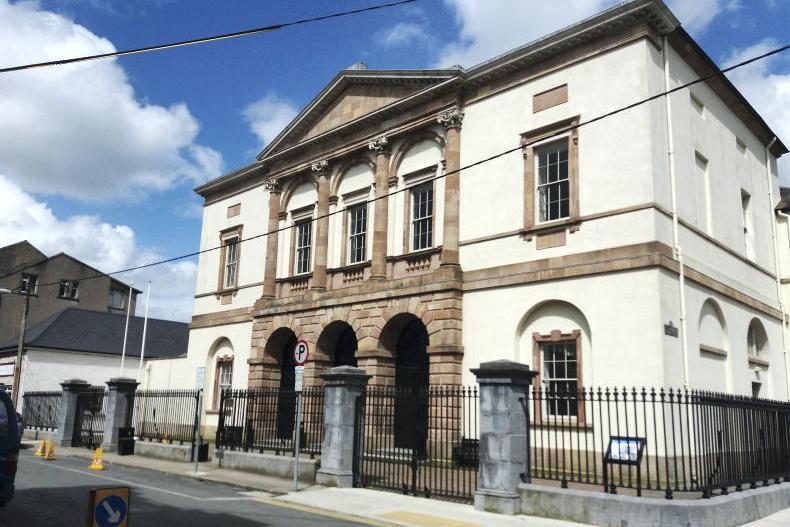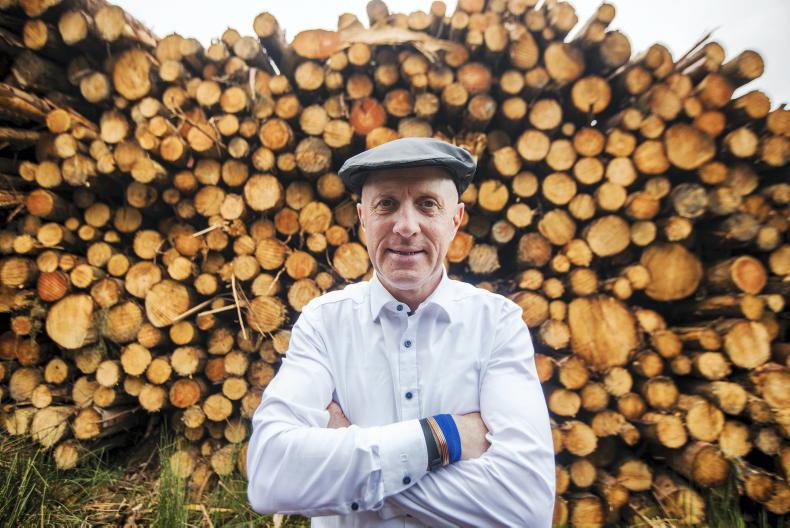Now that the new forestry programme is underway since 6 September, the Irish Farmers Journal plans to provide a monthly update on licence approvals, especially for afforestation.
The programme started promisingly when Minister Hackett told the Joint Oireachtas committee on 4 October that her department had “received 377 opt-ins for 3,412ha to date, and that afforestation licences began to issue last week [25-39 September]”.
She was referring to licences previously approved under the Forestry Programme (2015-2020), but licences issued up to the first week in November are far from encouraging, as opt-outs may well exceed opt-ins.
Only one afforestation licence was issued for September, but in the five weeks up to week ending 3 November, an average of four licences were issued each week, when at least 24 are required to achieve an annual afforestation programme of 8,000ha.
The programme should have been up and running since the beginning of October, as much of September involved discussions between the Department of Agriculture and foresters regarding the various planting schemes, the status of existing licences, and where planting can – and cannot – be carried out.
“The emphasis so far is on where forests cannot be established,” said one forestry company spokesperson.
The Irish Farmers Journal has been told by a company forester in the south that he is “unable to resubmit up to 55% of previously approved licensed sites, as they will not qualify under the new programme”.
In most instances, this is due mainly to environmental constraints, especially on peat sites.
Excluded
“We accept the new demanding peat threshold, but even good ecological and economic sites with an average peat depth of less than 30cm are now being rejected,” he said.
“We were led to believe that if the average peat threshold was less than 30cm, the site would be accepted; but even small pockets are now excluded, where the peat depth is marginally over 30cm,” he said.
“These are the guidelines now being issues, which the Department forestry inspectors have to enforce.”
An innovative licensing approach would allow these sites to be managed as commercial and ecological forests.
For example, native species could be planted on small areas where the peat depth marginally exceeds 30cm, or they could be retained as Areas of Biodiversity Enhancement (ABEs).
A typical example would be an approximate 10ha grassrush site, with an average peat depth under 30cm, but with fragmented parcels of land amounting to 3ha, with peat depths marginally greater than 30cm.
Even small pockets are now excluded, where the peat depth is marginally over 30cm
In a ‘common sense’ approach, the forest owner should be licensed to plant 6.5ha of conifers and manage the remaining 3.5ha as a combination of mixed native woodland and as an ABE.
Instead, the 3ha is removed for grant aid, leaving the owner with 7ha, which at best he/she can plant with conifers (maximum 4.5ha) and manage the remaining 35% (2.5ha) as native species, and open biodiverse areas within the 10ha block.
The productive area is now down to 45% of the planned site. In an instance such as this, the farmer opts out of what would be an unmanageable mosaic of planted and unplanted land.
Invariably, the farmer caught in this ‘catch-22’ decides to lease the land or continue to manage it in most instances as a suckler farm.
What should be a win-win for the farmer and forester ends up as an economic, social and environmental loss, which could be so easily avoided by the Department.
Large sawlog prices low, but pulpwood market steady
Apart from anecdotal information and timber sales surveys by the IFA, it has been difficult to determine log prices over the past two-and-a-half years.
Coillte withdrew price information in 2020 because of market sensitivities, while the Wood Price Quarterly (WPQ) struggled to compile data due to a combination of factors, not least the pandemic.
Suppliers of information to the WPQ – a confidential collaboration between UCD Forestry Section and the Irish Timber Growers Association (ITGA) – had other things on their minds since 2020.
COVID-19, post-Brexit market upheaval and felling licence appeals all intervened to create market uncertainty – and probably secrecy – about prices paid and received.
In the meantime, log prices fluctuated widely and, for a time, hit an unsustainably high level, especially during the second half of 2021. For a brief period, standing timber prices exceeded €100/m3.
During the latter part of 2022 and the past year, prices have fallen, especially for large sawlog, while prices for small logs (pulpwood) have remained steady.
Based on WPQ data, the market for large sawlog remains poor
Sawmillers, forestry companies and forestry consultants began providing price information to the WPQ for standing sales again this year (Table 1).
While the range of prices submitted for the first quarter was small, it increased for the second quarter when information for 117 sales was recorded, amounting for 162,299m3. The number of recorded sales fell for the third quarter to 31, which delivered 60,542m3 of logs.
Table 1 shows that prices around the €20/m3 mark are being achieved for pulpwood, especially for forests located near ports, as this export market – to UK board mills – is still strong. This is borne out in data for the third quarter, as verified by forestry companies.
The medium sawlog category-sized prices (€35-40/m3) in Table 1 are consistent with current anecdotal information.
The WPQ shows that large sawlog prices of €60/m3 are being realised.
More data would be required to be definitive on prices for large sawlog, as there are gaps in category prices, especially for logs greater than 0.7m3 for the quarter ending September.
Based on WPQ data and discussions with forestry companies and sawmills, the market for large sawlog remains poor and there is little evidence that prices have increased significantly since September.
The advice is to shop around, especially if clearfelling, as prices and log demand can vary by the month and location.
A further thinning may be advisable in forests located on wind-firm sites. This will provide cashflow until the market improves. The current price for large sawlog, at €60/m3, is at least 20% below what the forest owner should reasonably expect.
WPQ future
The WPQ received a welcome boost recently when the ITGA technical director, Donal Whelan, announced that the association “will continue to work with UCD in supporting the project”.
The price survey, which is confidential, is compiled by Assistant Professor, Amanda Sosa, of the School of Agriculture and Food Science, UCD, who took over this role from Professor Aine Ni Dhubhain earlier this year.

Assistant Professor, Amanda Sosa, School of Agriculture and Food Science, UCD compiles the WPQ data based on log sales from privately owned forests.
In addition to managing WPQ, Prof Sosa lectures in forest economics and forest planning and optimisation, as well as carrying out a number of forestry research projects.
Readers who have sold or purchased timber should submit prices in the standard roundwood sales data form, which can be obtained from UCD (email: roundwooddatabase@ucd.ie).
“The more price information gathered in compiling WPQ data, the more representative it will be for timber growers and the sector,” said Prof Sosa.
“Forest production forecasts show that significant volumes of timber growth in production output will be achieved into the 2030s from Ireland’s private forests,” said Donal Whelan.
“Continued accurate and reliable average roundwood price information will be critical for the development of the forestry sector,” he added.
Now that the new forestry programme is underway since 6 September, the Irish Farmers Journal plans to provide a monthly update on licence approvals, especially for afforestation.
The programme started promisingly when Minister Hackett told the Joint Oireachtas committee on 4 October that her department had “received 377 opt-ins for 3,412ha to date, and that afforestation licences began to issue last week [25-39 September]”.
She was referring to licences previously approved under the Forestry Programme (2015-2020), but licences issued up to the first week in November are far from encouraging, as opt-outs may well exceed opt-ins.
Only one afforestation licence was issued for September, but in the five weeks up to week ending 3 November, an average of four licences were issued each week, when at least 24 are required to achieve an annual afforestation programme of 8,000ha.
The programme should have been up and running since the beginning of October, as much of September involved discussions between the Department of Agriculture and foresters regarding the various planting schemes, the status of existing licences, and where planting can – and cannot – be carried out.
“The emphasis so far is on where forests cannot be established,” said one forestry company spokesperson.
The Irish Farmers Journal has been told by a company forester in the south that he is “unable to resubmit up to 55% of previously approved licensed sites, as they will not qualify under the new programme”.
In most instances, this is due mainly to environmental constraints, especially on peat sites.
Excluded
“We accept the new demanding peat threshold, but even good ecological and economic sites with an average peat depth of less than 30cm are now being rejected,” he said.
“We were led to believe that if the average peat threshold was less than 30cm, the site would be accepted; but even small pockets are now excluded, where the peat depth is marginally over 30cm,” he said.
“These are the guidelines now being issues, which the Department forestry inspectors have to enforce.”
An innovative licensing approach would allow these sites to be managed as commercial and ecological forests.
For example, native species could be planted on small areas where the peat depth marginally exceeds 30cm, or they could be retained as Areas of Biodiversity Enhancement (ABEs).
A typical example would be an approximate 10ha grassrush site, with an average peat depth under 30cm, but with fragmented parcels of land amounting to 3ha, with peat depths marginally greater than 30cm.
Even small pockets are now excluded, where the peat depth is marginally over 30cm
In a ‘common sense’ approach, the forest owner should be licensed to plant 6.5ha of conifers and manage the remaining 3.5ha as a combination of mixed native woodland and as an ABE.
Instead, the 3ha is removed for grant aid, leaving the owner with 7ha, which at best he/she can plant with conifers (maximum 4.5ha) and manage the remaining 35% (2.5ha) as native species, and open biodiverse areas within the 10ha block.
The productive area is now down to 45% of the planned site. In an instance such as this, the farmer opts out of what would be an unmanageable mosaic of planted and unplanted land.
Invariably, the farmer caught in this ‘catch-22’ decides to lease the land or continue to manage it in most instances as a suckler farm.
What should be a win-win for the farmer and forester ends up as an economic, social and environmental loss, which could be so easily avoided by the Department.
Large sawlog prices low, but pulpwood market steady
Apart from anecdotal information and timber sales surveys by the IFA, it has been difficult to determine log prices over the past two-and-a-half years.
Coillte withdrew price information in 2020 because of market sensitivities, while the Wood Price Quarterly (WPQ) struggled to compile data due to a combination of factors, not least the pandemic.
Suppliers of information to the WPQ – a confidential collaboration between UCD Forestry Section and the Irish Timber Growers Association (ITGA) – had other things on their minds since 2020.
COVID-19, post-Brexit market upheaval and felling licence appeals all intervened to create market uncertainty – and probably secrecy – about prices paid and received.
In the meantime, log prices fluctuated widely and, for a time, hit an unsustainably high level, especially during the second half of 2021. For a brief period, standing timber prices exceeded €100/m3.
During the latter part of 2022 and the past year, prices have fallen, especially for large sawlog, while prices for small logs (pulpwood) have remained steady.
Based on WPQ data, the market for large sawlog remains poor
Sawmillers, forestry companies and forestry consultants began providing price information to the WPQ for standing sales again this year (Table 1).
While the range of prices submitted for the first quarter was small, it increased for the second quarter when information for 117 sales was recorded, amounting for 162,299m3. The number of recorded sales fell for the third quarter to 31, which delivered 60,542m3 of logs.
Table 1 shows that prices around the €20/m3 mark are being achieved for pulpwood, especially for forests located near ports, as this export market – to UK board mills – is still strong. This is borne out in data for the third quarter, as verified by forestry companies.
The medium sawlog category-sized prices (€35-40/m3) in Table 1 are consistent with current anecdotal information.
The WPQ shows that large sawlog prices of €60/m3 are being realised.
More data would be required to be definitive on prices for large sawlog, as there are gaps in category prices, especially for logs greater than 0.7m3 for the quarter ending September.
Based on WPQ data and discussions with forestry companies and sawmills, the market for large sawlog remains poor and there is little evidence that prices have increased significantly since September.
The advice is to shop around, especially if clearfelling, as prices and log demand can vary by the month and location.
A further thinning may be advisable in forests located on wind-firm sites. This will provide cashflow until the market improves. The current price for large sawlog, at €60/m3, is at least 20% below what the forest owner should reasonably expect.
WPQ future
The WPQ received a welcome boost recently when the ITGA technical director, Donal Whelan, announced that the association “will continue to work with UCD in supporting the project”.
The price survey, which is confidential, is compiled by Assistant Professor, Amanda Sosa, of the School of Agriculture and Food Science, UCD, who took over this role from Professor Aine Ni Dhubhain earlier this year.

Assistant Professor, Amanda Sosa, School of Agriculture and Food Science, UCD compiles the WPQ data based on log sales from privately owned forests.
In addition to managing WPQ, Prof Sosa lectures in forest economics and forest planning and optimisation, as well as carrying out a number of forestry research projects.
Readers who have sold or purchased timber should submit prices in the standard roundwood sales data form, which can be obtained from UCD (email: roundwooddatabase@ucd.ie).
“The more price information gathered in compiling WPQ data, the more representative it will be for timber growers and the sector,” said Prof Sosa.
“Forest production forecasts show that significant volumes of timber growth in production output will be achieved into the 2030s from Ireland’s private forests,” said Donal Whelan.
“Continued accurate and reliable average roundwood price information will be critical for the development of the forestry sector,” he added.











SHARING OPTIONS